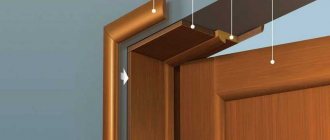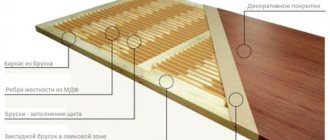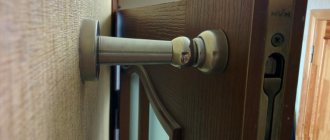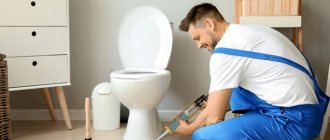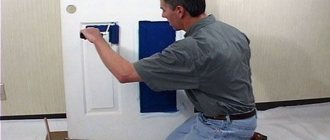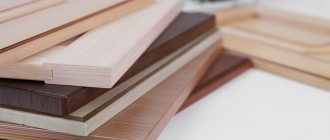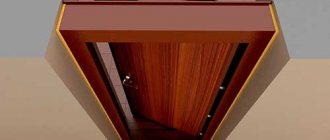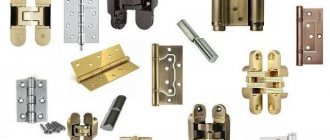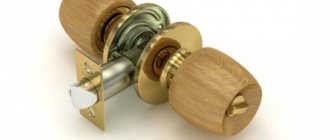Accessories
When choosing a door for your home, you need to pay attention to the design features and material; the performance of the product depends on this. You should immediately take a closer look at the fittings; they should be in harmony with the background of the door leaf and at the same time provide functionality.
The main element of the door is the lock; it must provide good protection against the entry of uninvited guests, therefore such a product must be durable and burglar-resistant.
But no matter how reliable the lock is, it still cannot provide one hundred percent security, so additional locking devices are installed on the door, such as latches, overhead hooks, and so on. Despite the simple mechanism, such fittings allow you to organize good protection.
Today the market offers many offers, among which you can choose fittings for each specific case. In this article we will talk about latches that are installed on both entrance and interior structures.
Gate valves for metal entrance structures
Gate valves for interior door structures
Repairing the front door handle - a simple restoration procedure
Based on their design, installation method and operating principle, door handles are classified into several categories.
Stationary handle
The standard handle has no moving parts and is not connected to the locking mechanism. It is needed to pull or push the door. It is a familiar button or U-shaped bracket with flanges for fastening with screws. There are overhead and through models.
Lever handle
A common design with a latch, which is also called socket or L-shaped. The handle is connected on both sides of the door by a tetrahedral insert that passes through the body of the mechanism embedded in the door leaf. The planks are attached to the canvas with self-tapping screws and closed with a decorative rosette, round or square, convex or flat. When you press the lever, the tongue hides inside and the door can open. The mechanism parts are returned to their original position by a spring. Available with a built-in lock for entrance doors to a house or apartment.
Rotary
The rotary handle or knob is found in several versions: with a latch, with a closing or locking mechanism. It has a spherical, conical or elongated shape. The lock button during installation is located on the inside of the room. From the outside, the handle is opened with a key or master key. The shape of the handle meets safety requirements and it is impossible to get injured.
Repair and installation of metal door handles
If the old handles are broken, you need to buy and install a new set. When choosing, you need to pay attention to the fact that their size and the shape of the keyhole are suitable for the type of door lock.
Push handles are installed on the entrance doors, activating the latch-lock. The exception is stationary and rotary (installed on doors in the 90s with a system of vertical struts).
Lever handles can be divided into two types:
- handles on a solid bar;
- handles with separate overlays.
Solid bar lever handles are used with latch and deadbolt locks. When selecting and installing a handle of this type, you must consider:
- center-to-center distance between the axis of the handle and the keyhole;
- pad width;
- section of a square;
- key hole shape.
When selecting separate handles, these parameters do not need to be taken into account. It is worth taking a closer look at the quality of workmanship and what metal they are made of. And of course choose the design you like. Imported locks and most domestic products do not come with handles.
Armored ABUS handles - protect the lock from burglary. Suitable for installation on DAAZ, ZAZ locks. For the category of customers who are unable to install a burglar-resistant door, an armored set will be very useful in terms of price-quality ratio, combining a reliable mechanism and an armored lining in one product.
Prices
Replacement or installation −1500 ₽
Sets - from 1200 ₽
| Replacing old handles on the front door: before and after |
Change Master Lock handles on Chinese doors
More than half of the handles for Chinese Outpost doors are made of low-quality alloys. The metal has increased fragility and low resistance to deformation and loads. The service life rarely reaches several years. They cannot be repaired. If problems arise with the handles of Masterlock locks, we can replace them with reinforced ones.
Principle of operation
The principle of operation is based on the physical attraction of magnetic materials (bar) to a source of constant magnetic field (magnet). Magnetic materials are alloys of iron with other metals. Permanent magnets are made from ferromagnetic alloys. The castings are exposed to a strong magnetic field, causing them to become magnetized, becoming a source of constant attraction.
The magnetic field acts at a short distance (5-25 mm), so the blade must be brought close enough to the bar.
Attention! Critics of magnetic clamps often claim that over time, the magnet supposedly loses its properties. Engineering tests have demonstrated that the field reserve in a modern magnet will last for 30-50 years. The door will probably have to be replaced.
The magnet is little affected by ambient temperature and humidity. The absence of moving parts operating under load ensures high reliability, low wear, and long product life.
Installing a door handle
Cases often arise when a door handle is broken, but the lock works fine and replacing it entirely is neither practical nor cheap. Most expensive imported locks are equipped with separate fittings: lock body, cylinder and handles. Therefore, installing a door handle separately will save a lot of money. When installing a new handle on a door with a lock, the customer needs to decide on the manufacturer, color scheme and model: on a bar or separate. However, if the handle on the bar breaks, then the model being installed must also be on the bar.
Magnetic locks AGB (Italy) - quality at an affordable price
Practicing craftsmen have many complaints about Chinese-made magnetic locks - often the magnetic latch simply does not work. To avoid getting into trouble, you should not skimp on accessories. The products of the Italian company AGB enjoy a good reputation, as evidenced by numerous positive reviews.
For marketing purposes, the term “smart magnetic lock” was introduced.
A smart magnetic lock that overcomes the most difficult climatic conditions. Created using innovative materials to ensure the lock operates even in extreme weather conditions (humidity, dust, chemicals).
Polaris 2XT is a smart magnetic lock from AGB.
The face plate is made of stainless steel. On request, the lock is available with a rectangular face plate. Polaris 2XT features quiet closing and precise mechanical connections that give a pleasant smooth handle and key turning feel.
Centro - magnetic lock with deadbolt
The adjustable Easy-Fix XT magnetic striker makes installation easy and the clamp system secures the insert into the striker
What to prepare for repairs and how to remove handles?
To repair the door handle of an iron door, you can simply call a specialist. In this case, you will have to spend a certain amount of money and adapt to his schedule. Most breakdowns are not so complex that they cannot be dealt with on their own. The main thing is not to rush, do everything carefully and according to the instructions.
To repair a metal door handle, you will need a set of screwdrivers, since in any case you cannot do without unscrewing the fasteners. Allen keys are also useful. Some repairs require an electric drill and hammer. In order to make markings, you should also have a marker at hand. To polish metal, you need sandpaper or a brush to work on it. When repairing fittings, in most cases you will have to remove them.
This happens in different ways, it all depends on the type of pen:
- It’s easier with a push-on design; one screwdriver is enough. The first step is to unscrew the screw that holds the decorative trim. It can then be easily removed through the handle. After this, all the screws are visible, they should be unscrewed and the mechanism can be removed.
- To dismantle the rotary model, you need a screwdriver and an awl. You can take another similar thin element. First, you need to remove the decorative rosettes, then a small technological hole will become visible on the side. You will need to insert an awl into it and move the pin. Then you can remove the handle.
If the handle model is round and has a mechanism for opening with a key, then the kit should include a tool (special key) for dismantling. Round products are removed from the side of the sash where there is no keyhole. It is enough to pry off the cover that covers the mount with a screwdriver. Remove the cover from the latch. Now the stopper is visible; you need to press it with a special key, while simultaneously pulling the handle. This will allow you to remove it. Next, you will need to unscrew the mounting screws and remove both handles. To remove the latch, use a screwdriver to unscrew the fixing screws.
Installation
If you are interested in how to make and install a door latch yourself, I will answer - there is nothing complicated here, the main thing is to want it, and the rest will follow. In order for the latch lock you made to correctly perform its direct functions, you need to take the installation seriously and follow a sequence of actions. We will look at how installation is carried out using the example of a latch installed inside the door leaf.
For this work you need to prepare the following tools:
- Electric or manual screw 6 mm. The first one is preferable.
- A drill designed for woodworking. Typically, a pen whose number is twenty to twenty-four is used to install the latch.
- Hex bit for screwdriver. For those who don’t know what it is, I’ll explain – it’s a special hexagon that is installed in a screwdriver with one side, and the other side is used to attach the required fastener.
- Pencil for marking.
- Regular roulette.
- Stage one. Mark the place where the latch will be located. Usually installation is carried out at a height of one hundred twenty to one hundred thirty centimeters from the floor. The thickness of the door leaf is four hundred and fifty centimeters.
- Stage two. It is required to determine the center of the end of the door leaf.
- Stage three. Using a drill, we measure the length of the latch and then bury the feather into the interior door leaf to the required depth.
- Stage four. We attach a latch to the outer part of the canvas and mark the place for installing the door handle, and use the same drill (feather) to drill a hole.
- Stage five. We insert the latch back into the hole that was made on the canvas and mark the fasteners.
- Stage six. We drill a hole for the fasteners; for this purpose you should use a pen number five.
That's all, there is nothing complicated in such work. You can see how the latch is inserted in this video review:
Briefly about the types of pens
With the current selection, choosing a door handle can be quite difficult. The topic of selection with photos and videos is covered in more detail “HERE” , and now we are talking about editing, so we will only go through the main positions of the direction.
- Overhead handles are considered the simplest; their installation is really extremely simple; you just need to choose the right installation location and screw in a few screws. The handles themselves can be wooden, metal or plastic, but the installation technology is the same for all;
- The through-mount handle is no more difficult to install than the previous version, but you will need a drill instead of a screwdriver. Here a through hole is drilled into which a metal pin with thread is inserted and handles on both sides of the door leaf are screwed onto this pin;
- Knob handles and rotary models are considered the most complex designs. I’m glad that the device, and therefore the installation technology, are similar for all these handles, so we will focus on these designs.
Conclusions and useful video on the topic
Video instructions for installing the latch:
In our article, we reviewed detailed instructions for installing a latch handle on an interior door. With its help, you can do it yourself without any problems. The task is simple even for people without special skills and practice.
Do you have any questions about installing the latch? Or would you like to share your personal experience of installing a latch handle? Write your recommendations, ask questions to our experts, add a photo of the finished work - the feedback block is located below.
Handles for the front door: design
- Stationary - is an independent element and is not connected to the locking mechanism. It is attached directly to the door leaf, most often has a U-shape, since, according to user reviews, it is the most convenient for opening. It can also be made in the form of a ball or even a loop. The stationary version is often used for decoration, giving the product an unusual, attractive look. This option is characterized by the greatest reliability, as it does not affect the strength characteristics of the door. It is recommended to choose this type of fittings for public institutions - schools, shops, etc.
- Push - connected to the latch, which allows you to keep the sash tightly closed, but not locked. When extended, the tongue rests against the socket of the strike plate and is held in place by a spring. When pressed, the spring compresses and the tongue disappears inside the lock. The mechanism ensures tight contact between the sash and the frame riser, which, in turn, facilitates closure.
Installation of push fittings is somewhat more complicated. To install, you need to drill through the door leaf and fix the handles on the rod on one side and the other, so when choosing, you should pay attention to the length of the pin. If necessary, the rod will have to be trimmed. It is recommended to choose the option with a separate trim for the front door, as it is much less demanding on the parameters. The photo shows a variant of the fittings.
Lever handles are often used with electronic locks.
- The turning or nob is also associated with the latch lock, but it must be turned to open the sash. As a rule, it has a spherical shape. On wooden doors you can also see an option where the knob is also connected to a locking mechanism - in this case, a keyhole is placed in the center of the knob. But this version is no longer used on modern designs. Any part that protrudes above the canvas - a handle, a cylinder lock cylinder - is a convenient lever for breaking, so it is recommended to choose devices in which the fittings and locking mechanisms are not one.
Bolt mechanism - latch
This is a unique design of a locking device designed for installation on door blocks. Initially, such devices were used for interior door structures with double leaves. They held one door, the second was constantly opening. If it was necessary to bring large objects into the room, the second part of the canvas was opened using a latch.
Today, such shutter devices are popular when arranging door blocks to the toilet and bathroom. The principle of operation of the mechanism is quite simple. You can install it yourself without calling a technician or having any skills.
An espagnolette is a budget option for latches that allows you to prevent unauthorized persons from entering the premises. Such latches have been used in everyday life for a long time and are still in demand among buyers. Today, the market also offers designer models of latch latches, which allow you to design door structures more stylishly.
Fastening the handles with ties.
Door ties are not the complicated hardware product pictured on the left.
It consists of a long screw and a cylinder into which the screw fits. The cylinder has an internal thread. The ties pass right through the door leaf and the lock and are tightened. Thus, they provide tightening of door handles. All locks, without exception, have through holes for this method of attaching handles. This way of fastening the handles is a much more reliable method, unlike the first one. The entire load on the handle is transferred to the stretch marks and there is virtually no chance of the handle being pulled out of the door leaf. In the first case, the load is transferred to the screws, which, with excessive force, can tear out the veneer and the upper surface of the wood into which they are screwed. The ties come complete with handles from the middle and high price segments, for example, Archie and Armadillo handles. Cheaper manufacturers do not always include ties included.
Standard type latches
Overhead latches are standard locking devices for doors that are not particularly complex in design. They are used for almost all models of interior doors.
The locking mechanism design includes a cylinder and a tongue. Their main function is to prevent spontaneous opening of the door leaf, for example, from drafts. There are many options for such products on sale.
Most often, overhead latches are installed on door blocks along with a handle, which is equipped with a special button. To close the door with a lock, just press the handle button and the tongue will move into the striker.
Such latches are called halyard latches. They consist of three components - a handle, a spring and a tongue, which can be made of steel or plastic. Due to the simplicity of the design, most consumers choose these models.
Types of handles for entrance doors
Depending on the type of door and functionality, door handles are divided into the following types:
- The stationary handle is a simple handle and is not equipped with a door locking system. Usually this is a round or U-shaped handle-bracket, or a ball. But there are also fantasy design models in the form of an outstretched hand, lizards and others.
- The push handle with a latch on the socket is equipped with a locking mechanism in the form of a latch, which is activated when the handle is pressed. The return spring in the mechanism ensures that the handle returns to its original position. The socket-shaped base provides an additional socket for a keyhole. The disadvantage of this design is that installation takes more time, but there is also a plus: if the lock or handle breaks, you only need to remove one base.
- The lever handle with a latch on the bar has the same principle of operation as in the previous paragraph, but the lock and latch are an integral mechanism. If the bar is not included in this case, it is necessary that the center-to-center distance from the center of the handle attachment to the lock cylinder corresponds to the distance between the slots on the bar. If, however, the handle and the lock are mounted separately, you need to select them so that the distance from the end of the door to the lock cylinder and to the square of the handle is the same.
Requirements for door hardware
A significant misconception is that the design of the door has a great influence on the quality of the door. All of them are necessarily equipped with a handle, which provides not only ease of use, but also gives them a complete appearance. Considering this factor, the appearance of the product is not so important.
Door handles are available in different sizes, as are door leaves. For a large door, this element of fittings of small dimensions and low quality is not the best solution, since such an option will quickly become unusable and require repair or even complete replacement.
In addition, it is important for each owner that the product provides a high level of security against unauthorized entry by third parties and prevents the cylinder from being knocked out. To solve this problem, you can give preference to a handle with a special protective lining made of a steel profile.
What can you fix yourself?
You can do the following handle repairs yourself:
- The handle falls out of the socket of the fastening strip if the locking ring, which sits in the groove at its end, comes off. The ring falls off for two reasons: it loosens or bursts. To determine whether the ring is intact or not, you need to remove the fastening strip from the door leaf. In this case, the ring (or its fragments) will fall out. If the ring is intact, you can try bending it to increase the clamping force. After this, the handle is inserted into the hole in the fastening bar and the ring is put on. After checking the reliability of the fastening, the mechanism is installed in place. If the ring has burst, it is unlikely to be replaced. In this case, you will need to replace the entire front door handle.
- If, after dismantling the fastening strip, it turns out that the square has burst, you can sigh: this breakdown can be repaired. Buying a new square is not a problem, just this time make sure that it is not silumin, but steel. Before installation, the square is cut with a grinder or hacksaw to the required length, the ends are rolled with a file.
- If the latch does not work, find out whether the reason lies in the length of the pin, or whether the return spring of the tongue inside the lock itself has come off. To do this, remove the fastening bar and use a screwdriver to check the functionality of the tongue by turning the square socket in the lock body. If the tongue works, then the pin needs to be lengthened. It's better to buy a new one and cut a piece to the correct length. You can put pads (cardboard, wood chips) into the socket at the end of the handle to prevent the pin from going too deep into it and falling out of the socket in the lock body.
Mechanism design
- If the spring has flown off and the mechanism does not return to its original position after pressing the lever, you must first also remove the fastening bar. The spring is attached under the retaining ring, which holds all the mechanisms together. Therefore, you will have to remove the retaining ring and fix the spring. If it bursts, then you can look and buy a new one. But usually in this case you will have to go shopping for a new door handle for the front door.
Video on how to remove and repair the push handle:
To remove the handle, check the integrity of its parts and determine the possibility of repair, you will need a screwdriver and no more than five minutes of time.
Selection principles
Standard magnetic door locks can withstand loads of up to 150 kg. This is more than enough for interior doors. But if for some reason a massive door structure is used, then it is necessary to select a lock according to the planned load.
Before installing the lock on the door, it is recommended to test it for lifting to assess the force required to open it. Experts advise not to install a powerful device on lightweight door structures, otherwise the door leaf may become deformed.
The magnetic lock securely locks the door in the closed position and is highly durable. The design of the lock does not contain complex parts that produce friction. Therefore, its breakdowns are not frequent, and in rare cases, individual parts of the bolt can be bought in a store and easily replaced yourself.
It is recommended to contact trusted manufacturers. The quality of their products is always at a high level, and they also have a guarantee on their products.

